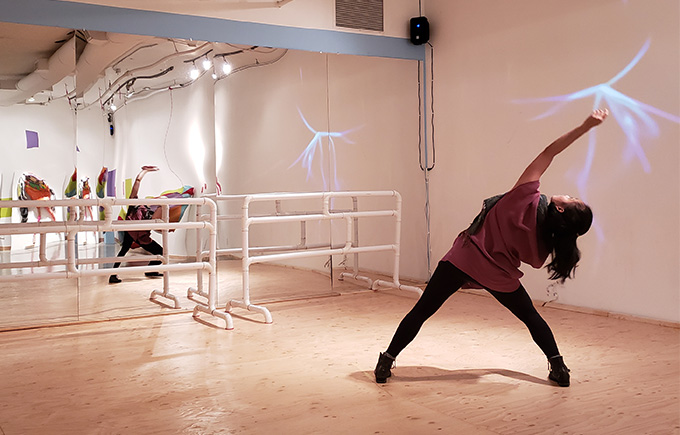December 05, 2018
Culture & Connection: Recap of Artist-in-Residence Tin Gamboa

Last month we welcomed our very first artist-in-residence to the ArtStarts Gallery as an engaging addition to our current exhibition, Movement is for Every Body. We asked Tin Gamboa to share about her experience, the project she developed while in residence at ArtStarts, and where we can find more of her work in the future.
1. Tell us about your artistic practice! Where did art start for you?
Art started for me when I was five or six years old, when I took ballet at École de Ballet Manille. I moved to Vancouver from the Philippines at the age of 18 and was introduced to contemporary dance at Simon Fraser University’s Dance program. Contemporary is a style that I am able to more sustainably integrate as a way of life, and as an open teacher from whom I can learn, via what I am willing to see and engage in.
My current art practice involves movement, dance film, experiential research, facilitation, and improvisation. The topics that my work revolves around are culture and connection. This year, my work has delved even deeper into these two topics, focusing on motherland and ancestry.
2. What drew you to apply for the Emerging Artist Residency at ArtStarts?
I was looking for an incubator for my practice, for research, and for movement. I was looking to feel supported. In addition, as someone who is greatly interested in facilitation styles and opening up conversation regarding motherland and vulnerability, I was happy that ArtStarts offered me opportunities to facilitate workshops with adult students in Early Childhood Education.
3. Did you have any specific goals for the residency, and if so, were you able to achieve them?
I was looking to sit with my questions. I was looking to sit with my work and with the unknown. I was also looking to involve guest artists into this work so that we may improvise, play, and explore questions surrounding motherland and ancestry. This was great as we were able to bounce ideas off of eachother and tap into some felt teachings through movement, sound, and discussion. For the most part, I was open to seeing where the residency would take me and it had proven to be a safe incubator for free exploration.
4. Your work explores themes of ancestors and ancestry. When you facilitated Gallery workshops during your residency, how did you explore these themes with the participants? How did they resonate with the groups?
My goals with the workshops for Early Childhood Education college students were to express the importance of movement in development and in learning. I also aimed to share, through the lens of my own work, how one can use creativity and generate movement — that movement could be as simple as gestures, and how one can take three simple gestures and extrapolate a myriad of movements to create a phrase. This creative process involved discussion of our individual motherlands as the theme for creation. Not only were we able to generate movement and understand movement from a heartfelt and different lens, but we were also able to tap into connection and vulnerability as we practiced conversation, reflection, and movement.
When I requested feedback at the end of the workshop, I heard comments such as: “I’m usually a shy person, but I felt so calm,” “I learned a lot from this. Thank you,” “I feel very relaxed,” and “We are doing this in class on Monday!“
5. What’s next for you, and where can we find more of your work?
I am still involved with Kathara Arts Collective, a re-Indigenizing group that aims to promote Indigenous culture through performance of our traditional Filipino song and dance. I will be continuing my relationship with them to keep learning about practices that originate from my motherland.
I will be dancing with Raven Spirit Dance in the upcoming months for a remount of a piece called Gathering Light. I am looking forward to learning from this company that expresses contemporary dance through Indigenous worldviews.
In regards to my own personal work, I am looking to share the vulnerability and honesty that is searching for my ancestry, lineage, and motherland and to share the exploration of being a Filipino on Coast Salish land. I hope to share this process of learning to be in right relationship with my motherland and ancestry while being in right relationship with the land I am currently on. I hope to openly continue this research and facilitate discussions around these topics. I hope to keep learning so that my knowledge of tradition and protocol can match the space in my heart that is wanting to hold space for others in this exploration.
Next month we will have Ralph Escamillan joining us from January 21st to February 8th. Learn more about Ralph here, or visit us to see the exhibition about our Emerging Artists on our mezzanine!
The artist-in-residence program is proudly supported by RBC Foundation's Emerging Artists Project.
Social Sharing
Past Stories
Search by category
Accessibility | AIC Projects | Arts Integration in Action | ArtStarts Artists | ArtStarts Team | Community Events and Engagement | Exhibitions | Grants | Guest Blog | Infusion Pro-D | Knowledge Philanthropist | Meet a Community Art Star | Showcase | Supporters | The Next 20

